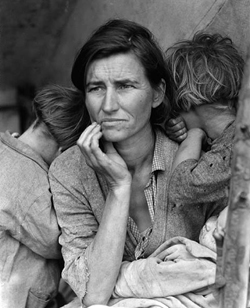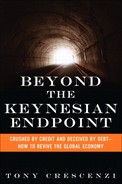10. Conclusion: The Transformation of a Century
As we contemplate our changed world and the challenges that lie ahead, consider these sentiments:
Adapt or perish, now as ever, is Nature’s inexorable imperative.
—H.G. Wells
A mother’s love is patient and forgiving when all others are forsaking, it never fails or falters, even though the heart is breaking.
—Helen Rice
We must never despair; our situation has been compromising before, and it has changed for the better; so I trust it will again. If difficulties arise, we must put forth new exertion and proportion our efforts to the exigencies of the times.
—George Washington
In February 1936, photographer Dorothea Lange sought to capture the desperate plight of the millions of migrant workers who sought to flee the Dust Bowl and the barren lands of the Great Plains, which were smitten by years of draught and dust storms at a time when there was already great suffering in the United States. On a pea farm in California, Lange sees a mother and her seven children sitting in a makeshift and torn open tent atop dried mud, their despondent faces covered with dust, their clothing soiled, their hands darkened with muck. As Lange draws yards nearer, two of the three children draped on their mother’s shoulders turn their heads away from Lange to the back of the tent, as if shamed. Without prompting, the woman, Florence Owens Thompson, tells of her plight, seeming to hope her story will ease her family’s suffering. The sad-faced woman tells Lange she and her children were living on vegetables from the fields upon which they labored, as well as on the meat of dead birds that the children had killed.
Source: Library of Congress; http://www.loc.gov/pictures/resource/fsa.8b29516/Source: Library of Congress

Lange snaps five photos in all, one of which becomes an iconic symbol of both the Great Depression and the Dust Bowl. Known as “Migrant Mother,” the photo brings greater awareness to the plight of the 2.5 million who migrated from the drought-stricken midwest in what remains the largest migration ever to occur in the United States over the time in which it occurred.
Figure 10-2. Protestors at the Hellenic Parliament in Athens, Greece, June 2011
Source: bigstockphoto.com (http://www.bigstockphoto.com/image-20885534/stock-photo-greek-protests-at-parliament-square-in-athens)

In the same month, John Maynard Keynes publishes a book titled, The General Theory of Employment, Interest, and Money. It offers a policy prescription that Keynes believes will increase employment and ease the hardship that millions of people are suffering through the Great Depression. Hardship for mankind is nothing new, and people for ages have shown a remarkable ability to adapt to even the most trying of circumstance. This puts the suffering of the Great Depression in its proper context. Nevertheless, modern society endeavors to ensure the dignity of its citizens and to limit human suffering. This creates rationale for government programs as well as for deficit spending. The Keynesian philosophy is transformational, and it feeds the evolution of modern society, including the United States, which moves away from the fiscal prudence it had shown since it enacted the Sinking Fund Act of 1795 to establish piggybanks to repay the national debt.
Politicians and the beneficiaries of their fiscal illusions for the past 80 years abused the newfound economic philosophy, relentlessly and dangerously pursuing the use of debt for self-aggrandizement. Today, the citizens of indebted nations bear a heavy burden and must begin repaying the debts. It is a Herculean task because the debts are mountainous. Yet there is no choice because the Keynesian Endpoint means that indebted nations have tapped the last balance sheet and can no longer use debt to attempt to solve their problems.
The financial crisis has shown that the use of debt to ease the suffering of people went too far. Consumers also went too far in using debt to fulfill their primal needs and their desire to display status and power and to “keep up with the Joneses.” Nevertheless, those who must now bear the burden of the solution to the world’s debt problems are fighting to preserve the status quo, fearing that any rollback of government spending will cause them to suffer. The problem is that their definition of suffering is enormously different from the suffering that ignited the Keynesian philosophy in the first place.
No member of modern society should ever live as the Migrant Mother did, living in a tattered tent and eating dead birds killed by her children. Government, in other words, should indeed endeavor to maintain the dignity of people and provide for at least a minimal standard of living. The people of the world must nonetheless recognize that there are limits to what government can do and that what remains of a nation’s tax receipts after it has done all it can to maintain the sanctity of human existence should be invested to help build a society that benefits all citizens.
This is the transformation that is now underway.
This is therefore not an endpoint but a beginning.
